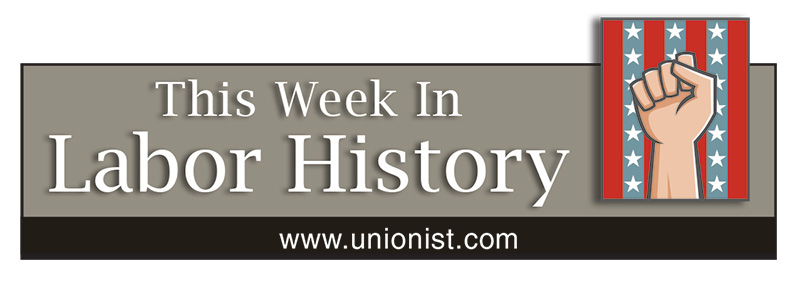This Week in Labor History June 17-23

JUNE 17
1903 – Mary Harris “Mother” Jones leads a rally in Philadelphia to focus public attention on children mutilated in the state’s textile mills. Three weeks later, the 73-year-old will lead a march to New York City to plead with President Theodore Roosevelt to help improve conditions for the children.
1972 – Nine fire fighters are killed, eight more injured when a large section of Boston’s Hotel Vendom collapses on them. The fire fighters were performing cleanup when the collapse occurred, having successfully fought a fire at the luxury hotel earlier in the day.
JUNE 18
1941 – Union and civil rights leader A. Philip Randolph and others meet with President Roosevelt about a proposed July 1 March on Washington to protest discrimination in war industries.
JUNE 19
1912 – Eight-hour work day adopted for federal employees.
1917 – AFL President Sam Gompers and Secretary of War Newton Baker sign an agreement establishing a three-member board of adjustment to control wages, hours and working conditions for construction workers employed on government projects.
1934 – A pioneering sit-down strike is conducted by workers at a General Tire Co. factory in Akron, Ohio. The United Rubber Workers union was founded a year later.
JUNE 20
1893 – The American Railway Union, headed by Eugene Debs, is founded in Chicago. In the Pullman strike a year later, the union was defeated by federal injunctions and troops, and Debs was imprisoned for violating the injunctions.
1947 – The Taft-Hartley Labor Management Relations Act, curbing strikes, is vetoed by President Harry S. Truman. The veto was overridden three days later by a Republican-controlled Congress.
JUNE 21
1948 – The U.S. Supreme Court upholds the right of unions to publish statements urging members to vote for a specific congressional candidate, ruling that such advocacy is not a violation of the Federal Corrupt Practices Act.
1997 – An estimated 100,000 unionists and other supporters march in solidarity with striking Detroit News and Detroit Free Press newspaper workers.
JUNE 22
1918 – A total of 86 passengers on a train carrying members of the Hagenbeck-Wallace Circus are killed, another 127 injured in a wreck near Hammond, Ind. Five days later, the dead are buried in Woodlawn Cemetery in Forest Park, Ill., in an area set aside as Showmen’s Rest, purchased only a few months earlier by the Showmen’s League of America.
1922 – Violence erupted during a coal mine strike at Herrin, Ill. A total of 36 were killed, 21 of them non-union miners.
JUNE 23
1914 – Charles Moyer, president of the Western Federation of Miners, goes to Butte, Mont. in an attempt to mediate a conflict between factions of the miner’s local there. It didn’t go well.
1947 – Congress overrides President Harry Truman’s veto of the anti-worker Taft-Hartley Act. The law weakened unions and let states exempt themselves from union requirements. Twenty states immediately enacted open shop laws and more followed.
1978 – OSHA issues standard on cotton dust to protect 600,000 workers from byssinosis, also known as “brown lung.”
(Compiled by David Prosten, founder Union Communication Services)


Leave a Reply